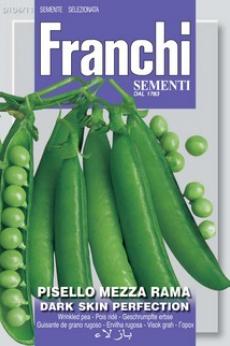
Pea, Dark Skin Perfection
Pea Dark Skin Perfection Mid-Early Pea. Dark green pod with 9-10 peas per pod.
For many, sweet, green pea pods evoke memories of sitting on the porch in a rocking chair, shelling peas and sharing the day's events on warm summer nights. Continue those lazy, happy times by adding Dark Skin Perfection (Pisum sativum) to your garden.
Perfection Dark-Seeded Peas Plant Characteristics: Also known as Early Perfection, this variety yields a high volume of sweet, tender peas that hold up well to both canning and freezing. They will produce both spring and fall crops, extending your enjoyment of fresh peas, and providing enough to preserve for the whole year. Best grown on a trellis system, Early Perfection peas are container friendly, drought-hardy, and disease-resistant, including resistance to fusarium wilt. The prolific vines grow to about 30 inches long and produce 3-inch pods that contain seven to 10 peas each. The peas may be vulnerable to mildew and mosaic, but you can reduce the risks by not planting them where other legumes have grown and by dusting them with a powdered inoculant before planting. Leafhoppers sometimes visit Early Perfection peas, but natural predators will generally keep them under control, and, if that doesn't work, a gentle water spray to remove the nymphs solves the problem.
Uses of Dark Skin Perfection Peas: Peas are rich in Vitamins C and B6, along with folate, iron, and phytochemicals, so they are a healthy addition to your menu, as well as a delicious one. Boil them lightly for 3 to 5 minutes or toss them, cooked or raw, into a mixed salad. You can also make a quick pea salad. Use the tender young peas raw or blanch them in boiling water, followed by an ice bath. Mix them with chopped red onion, cubed or grated Cheddar cheese, and just enough mayonnaise or salad dressing to bind everything together.
Or opt for a delicious minted pea soup. Start by sautéing 1 cup onions and 2 cups leeks in butter, just until the onions are tender -- about 7 minutes. Add 4 cups chicken stock; bring everything to a boil. Add 5 cups of fresh shelled peas and cook the mixture for 5 minutes. Remove it from the heat and add 2/3 cup mint leaves and salt and pepper to taste. Puree the mixture in batches, then add 1/2 cup crème fraiche or sour cream and 1/2 cup fresh chopped chives. Garnish with a dollop of crème fraiche and a sprinkle of chives.
SOWING THE SEED: Peas love the cooler temperatures of Spring & Fall, so they should be sown indoors 6 to 8 weeks prior to the last frost, or sown directly outdoors when all danger of frost has passed. If sowing indoors, sow in peat pots at a depth of 1” deep. Transplant entire peat pots outdoors when the weather is mildly warm.
GROWING CONDITIONS: As explained above, Peas thrive in the cooler temperatures of Spring and Fall. They prefer an area of full sunlight and aren’t too picky on soil conditions. Just make sure that the sowing area is well drained and doesn’t contain clay. To improve drainage, we recommend adding a light compost to areas that contain hard, compact soil. Water daily until germination occurs.
GERMINATION & GROWTH: Peas will typically take about 7 to 14 days to germinate, if optimal conditions are met. The plants themselves will reach a mature height of roughly 30 inches tall and can spread about 18 to 24 inches wide. You can space each plant 18 to 24 inches apart, in rows that are spaced about 3 to 4 feet apart. Perfection Dark Seed is best grown with supports. Harvest in roughly 65 to 70 days.
English peas have a large bright green pod which encases plump, round peas or berries. The pods grow on vines and unlike snow and sugar snap peas are too fibrous to be edible. Pods must be shelled first by snapping off the end and pulling the fibrous string along the length of the pod. Each pod contains five to eight emerald hued peas. Peas have a tender yet slightly crunchy texture and a sweet pea flavor. For best flavor prepare or freeze peas soon after they are harvested, the high sugar content of the peas begin to convert to starch as soon as the peas are picked from the vine.
A versatile vegetable, fresh english peas are sweet and tender enough to be eaten raw but may also be prepared cooked. Shelled peas can be blanched and pureed to make a spread or dip. Add raw peas to green and grain salads. Their sweet, fresh flavor will complement rich pasta and risotto as well as spicy curries and soups. The shells of english peas can be used to add flavor to vegetable stock. For best flavor and texture wait to shell peas till you are ready to use them. Peas can also be shelled and frozen, dried or canned for future use.
Peas date back to ancient times and are believed to be native to Europe and parts of Asia. Cultivation of peas however is thought to have begun in the seventeenth century when plant breeders in England began developing new and improved varieties of garden peas. The modern english pea was named as such due to the plethora of new varieties that were breed there. Because of their long shelf life dried peas traveled to the new world with explorers and became one of the first crops grown by early colonists. An Austrian monk, Gregor Mendel, performed famous plant breeding experiments in the second half of the nineteenth century and used peas as his basis. His work with pea plants is perceived as the foundation of modern genetics.
